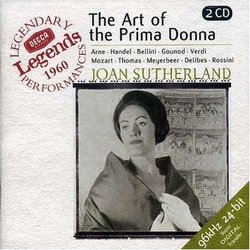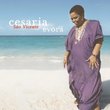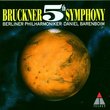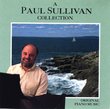| All Artists: Thomas Arne, George Frederick Handel, Vincenzo Bellini, Gioachino Rossini, Charles Gounod, Giuseppe Verdi, Wolfgang Amadeus Mozart, Ambroise Thomas, Leo Delibes, Giacomo Meyerbeer, Joan Sutherland Title: The Art of the Prima Donna Members Wishing: 0 Total Copies: 0 Label: Decca Release Date: 10/10/2000 Album Type: Original recording remastered Genre: Classical Styles: Opera & Classical Vocal, Historical Periods, Baroque (c.1600-1750), Classical (c.1770-1830), Romantic (c.1820-1910) Number of Discs: 2 SwapaCD Credits: 2 UPC: 028946711521 |
Search - Thomas Arne, George Frederick Handel, Vincenzo Bellini :: The Art of the Prima Donna
 | Thomas Arne, George Frederick Handel, Vincenzo Bellini The Art of the Prima Donna Genre: Classical
No Description Available. Genre: Classical Music Media Format: Compact Disk Rating: Release Date: 10-OCT-2000 |
Larger Image |
CD DetailsSynopsis
Product Description No Description Available. Genre: Classical Music Media Format: Compact Disk Rating: Release Date: 10-OCT-2000 Similarly Requested CDs
|
CD ReviewsThe recital of a lifetime fungpuibong | Beverly, Hills, L.A. | 11/25/2001 (5 out of 5 stars) "This recital by a very young Joan Sutherland, was one of her earliest, and by far her best. It has been beautifully remastered, showing the Sutherland sound in all her past splendor.The condition of Sutherland's golden voice here is indescribably gorgeous. The ring in her soprano is thrilling. The trills are just about as good as it can get ( Remember, there are two notes in a trill, a phenomenon that only La Stupenda can accomplish ). The scales and arpeggios are so accurate that it is simply a marvel! But it is the enormous size of the voice, especially at the top half of the stratosphere that makes Dame Joan beyond comparison.The highlights here are - everything! A two cd set that sets the standard for all coloratura sopranos of the past, present, and future. First, the difficulty of the program. I read that Sutherland recorded all of these arias in one take in a time frame of two days. I don't remember ever hearing so many extreme high notes in one sitting ( up to E natural, and there are three of these in Semiramide's "Bel raggio" alone ) . Another several high E in the "Bell song". If you think that Sutherland's singing of the "Bell Song is super in her recording of Lakme, you should listen to this one." The staccato is fast. In bel canto, the shorter a staccato is, the more precise the technique. Meaning, that when she attacks a staccato, she releases it in the split of a second. Of the coloraturas of the last century, Only Amelita Galli-Curci has a better staccato than Sutherland ( but of course Galli-Curci did not have nearly the voice or trill as Sutherland ).The aria from Les Hugenots is a shere technical achievement that is so stunning that words can't describe. Let's just say, in that aria ( and all the other arias in this recording, as well ), she attacks every trill, scale, and high notes with such ease that you would think that she was an instrument like a flute, not a human being.The great aria "Marten alle arten" is a concerto for soprano and orchestra. And it is thrilling to hear the aria sung as Mozart would have envisioned - with its long phrases taken without any breaths. ( Beverly Sills also sings this aria extremely well ). The mad scene from Il Puritani is glorious! Sutherland sounds so sad and convincing, which was something that she was not known for. The high E flat that crowns the end of the aria is one of her very best.Now, if you want to hear what a trill is supposed to sound like, I suggest the "Jewel Song".Now, that's what a trill is suppose to sound like - its two notes completely separate from each other. A trill is the most difficult element in coloratura singing, and having a great trill can make a great coloratura soprano a legend. Of the opera singers of the last century, only the following had a "real" trill: Joan Sutherland, Beverly Sills, Maria Tetrazinni, and Nellie Melba.Finally, let me comment on the vast improvement of Decca's state of the art remastering of this classic recording. Decca's engineers have basically restore the true Sutherland sound. And in doing so, future opera fans will hear what a true coloratura is supposed to sound like. ." FIVE STAR POWER! MOVIE MAVEN | New York, NY USA | 12/23/2000 (5 out of 5 stars) "Joan Sutherland's voice is not one of those typically fruity, bird-like sopranos that goes up to stratospheric notes that only dogs can hear. Sutherland does have the agility and rock-solid technique and grace and magnificent talent to reach those notes that seem to reach the heavens, but she has body and warmth and strength too. Hers is truly a once-in-a-lifetime voice and this set of two cd's is the perfect way to either be introduced to her talents or to share your fond memories of her. She sings arias from Verdi, Mozart, Gounod, etc. and, of course, coloratura favorites from Bellini and Rossini. The sound on this set from 1960 is superb. Sutherland's singing is never anything less than glorious." Joan was never better Ivy Lin | NY NY | 03/20/2002 (5 out of 5 stars) "This album is a bittersweet experience. In 1959, Joan Sutherland, a friendly, down-to-earth Aussie, burst onto the scene as Lucia di Lammermoor. She became an overnight sensation, her bright, bell-like voice and seemingly perfect technique wowing everyone. The record companies quickly noticed. This album, a 'tribute' to past prima donnas, came out in 1960 and demonstrates what the fuss was all about. Joan had ARRIVED -- she was now a great Prima Donna. The clear, silvery, bell-like voice, the incredible upper range, the amazing trills, and, most of all, a freshness and youth that made listening to her like drinking a glass of bubbles. Of all the selections I am particularly fond of the Sonnambula scene. I really felt like I was possibly listening to Jenny Lind. But all of the selections are wonderful. A particularly lovely moment is her top B-flats in Casta diva (sung in original key for once). The brightness and radiance of her voice is truly like listening to a bunch of singing diamonds. There is perhaps not much deep characterization, but the purity and sumptuousness of her singing is valuable enough in itself. Then, in 1961, something happened. Her technical wizardry remained untouched, but it was a different singer. The voice became much darker, lost all its silvery sheen, and she developed rather annoyingly 'droopy' mannerisms. She started to slack behind the conductor's beat, as if she were a perpetual turtle following a hare. Worst of all, her diction became atrocious (for anyone who thinks she started out with bad diction just listen to this album, where it is fine). The consonants (particularly 'b'and 'd', which are for all intents and purposes indistinguishable) became soft and mushy, the vowels distorted (everything became 'aw' and 'ooo'). Diction hit rock bottom in her 1964 recording of Norma, which is completely incomprehensible. By the 1970's she got some of the consonants back, but the lovely, youthful sounding, bell-like voice heard in 1959-60 was gone forever. People speculate on the reasons, but most people think it was some sort of health crisis that prompted her to rework her voice. For this reason listening to this album is bittersweet. Joan just wasnt the same after this. But GET THIS ALBUM! Even for non-Joan fans, this is a must for great singing."
|

 Track Listings (8) - Disc #1
Track Listings (8) - Disc #1


